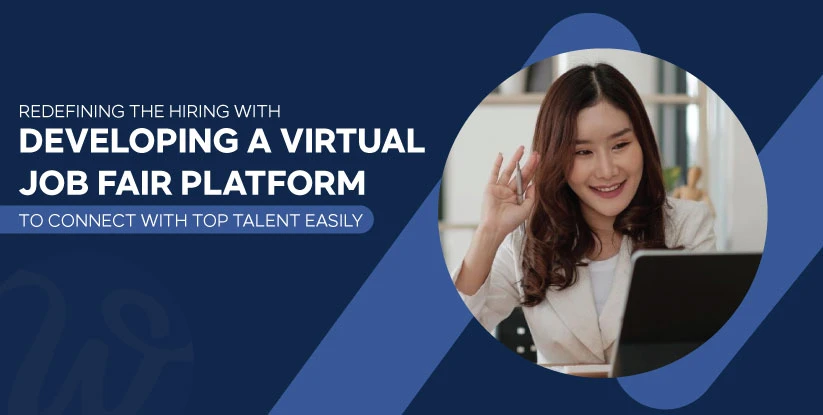Redefining the Hiring with Developing a Virtual Job Fair Platform to Connect with Top Talent Easily?

In a virtual job fair, recruiters and employers connect with top talent easily. They talk to job seekers online through the intranet. This includes recent graduates and experienced professionals.
Attendees can visit any booth from home. They explore companies, ask questions, and learn more about job roles. They also get a chance to network without leaving their house.
The benefits of Virtual job fairs is cost less than traditional ones. You don’t need to spend on travel, venues, or printed materials. Plus, you can invite people from all over the world. This expands your reach and brings in more talent. Now that you know how to hold a virtual job fair using simple steps, let’s explore why these events are so important.
Importance of virtual job fair
 Virtual events
Virtual events break the limits of physical location. In-person career fairs often target people who live nearby. But virtual events let you connect with talent from anywhere in the world. You can meet top candidates with just a click. It’s a fast and flexible way to find the right people, no matter where they are.
In addition to being more accessible and convenient for
job searchers, virtual career fairs are more likely to have more excellent participation rates and more hiring possibilities than in-person career fairs.
Online career fairs cost a lot less than traditional ones. For
virtual hiring, there are no venue fees, no travel expenditures, and substantially less personnel requirements. It is possible to host a virtual job fair with just one or two recruiters. Furthermore, there are no extra fees for gifts or drinks.
At a
virtual job fair, you can have multiple one-on-one private conversations. Because everything is done online, you can communicate with several prospects at once. As a result, connecting with potential prospects during a virtual career fair is simpler than you could hope to do so at an in-person event where you can only speak to one person at a time.
-
Marketing for recruiting is improved
Your recruitment marketing efforts will be more effective with the help of
online career fair. Because applicants know how practical an online event can be, you may issue invites to a specific group from your talent database or applicant tracking system (ATS). Virtual career fairs have a 50% attendance rate compared to in-person professional events, which is pretty high.
A virtual career fair helps you check candidate quality right on the platform. You can quickly see who stands out. It also gives you useful data to shape your conversational recruiting strategy. You’ll know what’s working and where to improve.
From the same platform, you can move strong candidates forward. Send them to a phone screen, schedule an interview, or add them to your follow-up pipeline. You can manage all candidates without leaving the virtual career fair tool.
How to develop a virtual job fair?
Consider carefully when choosing the finest virtual job fair platforms for your event. Live broadcasts, chat rooms, branded booths, and the ability to upload films and presentations are among the standard elements that most virtual job fair platforms offer. It would be best to consider whether the online
job fair platform can be customized for smartphone users and whether resume access is available. When choosing the internet platform, consider the type of audience you intend to Connect With Top Talent Easily.
Once you list your needs, plan your budget. A virtual job fair usually costs less than a physical event. But it can include new types of expenses. You may need to pay for the online platform or special software.
Some tools might be free. That can help cut down your costs. But don’t choose tools in a hurry. Compare different ATS and recruiting software before making a final decision. The cost of a virtual job fair depends on how big the event is and what your company needs. There’s no fixed price. Plan based on your goals and the tools required.
-
Select the proper platform
There are several platforms now available that provide virtual event solutions. Choosing the Connect With Top Talent Easily challenging when so many possibilities are available. It would be best to consider the following criteria when selecting a virtual event platform.
-
- Engagement
- Branding
- Networking
- Visualization in 3D
- Security
- Admin Dashboards & Analytics
-
Create alliances and begin hiring
Before the actual day of the virtual career fair, recruitment agencies, employers, companies, and guest or expert speakers should be contacted. Present the fair to potential partners so you may attend the event and profit from their efforts. It is best to approach potential partners with a well-developed plan and strategy, followed by clearly specified deadlines. This gives your online job fair legitimacy. You might contact your potential partners via appropriate communication channels like phone, email, or social media.
-
Obtaining Sponsors and Exhibitors
Now it’s time to reach out to potential employers, speakers, experts, and exhibitors. Tell them about your virtual job fair and what they’ll gain by joining.
Share clear details. Let them know how many attendees you expect. Talk about the type of audience they’ll meet. Explain how the event will be managed and how everything will run smoothly. If you’re looking for sponsors, this is a great time to pitch your sponsorship packages. Show them the benefits of supporting your virtual job fair.
Make sure you prepare before you contact them. Have your event plan, schedule, and strategy ready. This helps you explain the value of your event with confidence.
What are the features you must include in a Virtual job fair?

By simulating the actual world, creating an immersive
3D design for virtual job fairs may give your audience unforgettable experiences. Therefore, utilizing 3D interface designs is just as crucial when choosing a location for physical events.
Unlike a webinar, a virtual job fair is much more than that. As a result, every virtual venue, including virtual auditoriums, exhibit halls, and lobbies, must include some form of 3D feature to make it stand out.
No event is complete without webinars. To keep guests interested, use immersive visual content. Live sessions let companies show what makes their business unique. They also explain why students should apply. To create an engaging experience, choose a platform that supports live or recorded sessions.
Employer representatives can quickly shortlist candidates using search criteria to check for pertinent skills and qualifications. In essence, this aids in slicing through the noise and focusing directly on what employers are seeking is on of the
features of virtual job fair platforms.
-
Optimizing attendance with a Landing page
A career page with details about the occasion and the kinds of people you want has to be included on a
landing page for Job Fairs. An overview, a timetable, an agenda, exhibitor information, instructions, and other essential details have to be on this landing page.
Virtual job fair vs. Traditional job fair

Virtual and physical fairs both provide participants with value; they make different promises. To help you think about what virtual career fairs may accomplish for you, we have condensed it down to the few most important distinctions.
The logistics of storing and moving actual papers before and after the event will be taken care of for prospective employers. Everything is digitally archived, which will speed up the recruiting procedure overall. Without going through countless paper records, exhibitors may instantly interact with former attendees by accessing the database.
The physical fair is open to participants currently abroad or visitors from other nations.
ROI of virtual job fairs thus has a more prominent and maybe limitless reach.
It’s simple to attend online employment fairs no matter where you reside. You only need a reliable WiFi connection to research employment prospects with businesses worldwide. Traditional job fairs need you to attend physically, so your Connect With Top Talent Easily are limited by where you live.
Final word
A
virtual job fair engagement may assist businesses of all sizes in marketing their brands,
connect with top talent easily and be an excellent method for connecting with a larger spectrum of job searchers. On the other hand, it is also a terrific opportunity for graduates and job seekers to discover employment prospects in the comfort and security of their own homes.
Therefore, we’ve outlined the procedures and practical advice you may use to organize and manage a fruitful virtual
job fair event above. You must also check our blog if you want updates on Trending topics or anything similar. Keep in touch!
Follow for more on:
LinkedIn
Frequently Asked Questions
A virtual job fair platform is an online setting that mimics the ease and reach of a physical job fair, allowing businesses and job seekers to connect and engage in real time.
Increased user experience through capabilities like video conferencing, chat, and document sharing, as well as broader reach, cost-effectiveness, time savings, real-time engagement, and data analytics, are among the advantages.
Ensure intuitive navigation, clean and responsive design, clear instructions, easy access to key features, and thorough testing to identify and fix any usability issues
Highlight the benefits of virtual job fairs, offer early-bird discounts, provide testimonials and case studies, engage in direct outreach, and partner with industry associations and recruitment agencies.
Key metrics include the number of attendees, cost per hire, time-to-hire, engagement rates (e.g., chat interactions, video calls), candidate satisfaction scores, conversion rates from attendees to applicants, and overall event costs.
Tools like Google Analytics, Hotjar, or HubSpot can provide insights into traffic patterns, user behavior on the page, conversion rates, and other relevant metrics to optimize the landing page and improve event promotion strategies.



 Virtual and physical fairs both provide participants with value; they make different promises. To help you think about what virtual career fairs may accomplish for you, we have condensed it down to the few most important distinctions.
Virtual and physical fairs both provide participants with value; they make different promises. To help you think about what virtual career fairs may accomplish for you, we have condensed it down to the few most important distinctions.

